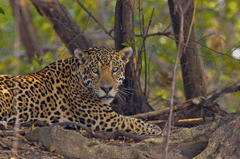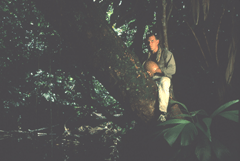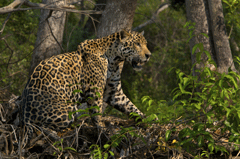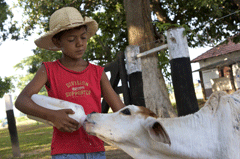A Home for Jaguars
Air Date: Week of May 8, 2009
 |
Jaguars travel amazing distances on their migration routes – trekking from Mexico all the way through most of South America. They cross canals, towns, ranches and plenty of people who are less than happy to see them. Host Jeff Young talks with Dr. Alan Rabinowitz, president of the conservationist group, Panthera, about a novel way to get humans to co-exist with cats.
Transcript
YOUNG: Many of the world’s wild cats face dire threats – shrinking habitat, severed migration routes, and human hunters.
A non-profit group called Panthera is dedicated to preserving the thirty-six species of wild cats. And it’s using some very creative approaches. Its latest project aims to help jaguars in Brazil by first helping people there live better.
Panthera’s president, Dr. Alan Rabinowitz, has long struggled to find effective ways to conserve habitat for these big cats, which have had a deep hold on him for decades.

Alan Rabinowitz on the lookout for jaguars in Belize. (Photo: Steve Winter/Panthera.org)
RABINOWITZ: I’ve been involved with jaguars since the late 1970s. It was the first thing I actually did after graduate school, and I was the first one to radio collar jaguars in the jungles and set up the world’s first jaguar preserve in Belize. But since that time we’ve come to realize that jaguars genetically are actually the same from Mexico through Argentina, which was an incredible piece of news when the genetic tools allowed us to discover this. And that took us into a completely new conservation model that instead of following the old traditional paradigm of saving a species by just trying to lock it up in good protected areas – now we have be trying over the last five years to save the jaguar throughout its entire contiguous range, from Mexico through Argentina. While we thought they were being restricted, they were actually coming out of the protected areas and finding their own way between large pockets of forest, even swimming the Panama Canal.
YOUNG: That’s amazing. I mean, yeah – how do they get across the canal?

A jaguar approaching a cattle fence in the Brazilian Pantanal. (Photo: Steve Winter/Panthera.org)
RABINOWITZ: That was the first thing I wondered, and I headed straight down to the Panama Canal when I got this news. And sure enough, there’s a great section on the Atlantic coast of the Panama Canal which is solid jungle up to the canal and solid jungle on the other side, and it’s not that wide. It’s wide enough frankly for you and I to swim across. It’s not as if every jaguar that comes there swims across, but to maintain genetic continuity all you need is one jaguar every four or five generations to actually make it across, one young dispersing male usually, and get to the next side.
YOUNG: And that’s keeping them from breaking up into separate geographically discrete populations and becoming separate subspecies.
RABINOWITZ: Exactly. One of the most important - where the largest jaguars on record have always been – is in the Brazilian Pantanal, almost the southern extremity of its range. That area has some of the densest jaguar populations we know throughout its range, and yet it’s very much in threat of being cut off from the rest of jaguar range.
YOUNG: Now the Pantanal – that’s a swamp, right?
RABINOWITZ: It’s the world’s largest swampland, yes.

A young rancher feeds a calf on Panthera’s Sao Bento Ranch in the Pantanal. Ranchers blame jaguars for killing cattle. (Photo: Steve Winter/Panthera.org)
YOUNG: It’s also, as I understand it, ranching country. And, you know, my understanding of ranching is that they don’t much like big predators, do they?
RABINOWITZ: Exactly. In ranching country jaguars are viewed as cattle killers, even though the reason most cattle die on these huge, huge ranches are numerous and varied. But jaguars are blamed for almost all the cattle deaths by the ranchers, so it’s been a tradition, it’s a been a history in much ranching country to kill jaguars on sight in order to prevent them from killing cattle and thus losing money.
YOUNG: So, what are you doing to try to get ranchers to get along with jaguars?
RABINOWITZ: So Panthera was involved in actually purchasing some of the ranches, which were up for sale, which allowed us to create the largest Jaguar biological corridor throughout jaguar range. We saved a huge amount of land because there was protected area on both sides and we then hooked it up. If there’s any lesson we’ve learned over the years in conservation, it’s that no matter how many laws you make and now matter how many protected areas you set up, unless you can work with the local people in these areas, then long-term sustainable conservation just will not work.

A watchful jaguar in the Pantanal. (Photo: Steve Winter/Panthera.org)
YOUNG: So how do you do that? How do you make them see benefit in having these big cats around them?
RABINOWITZ: We need to know first what they’re greatest needs are, what they’re perceived needs and desires are. And in the Pantanal they involve basically everything we all want: better lives for their children. So we create incentives or benefits for them living within this jaguar corridor, and those benefits are in the way of setting up schools and bringing health care. And that led us to this incredibly innovative partnership with Mount Sinai Medical School here in New York.
YOUNG: Yeah, tell me about that. This is taking med students from Mount Sinai to what offer services there in Brazil?
RABINOWITZ: We’re not just bringing doctors down. These doctors also have to be trained in conservation. So when the doctors go, they don’t just go there as medical doctors, they go there as conservation medical practitioners.
YOUNG: This is such a fascinating approach. I know form personal experience that often a visit to the doctor is what they call a teachable moment where I’m a little more receptive to messages.
RABINOWITZ: Exactly. Local people often more than urban dwellers really understand the balance between the environment and human health because they live with it every day. So when you start teaching them how maybe part of the reason why their child has this fever or why some of their maladies are occurring has to do with both their livestock and how they keep it or the fact that there are wild jaguars out there and they’re actually living in a nice balanced wild environment, they get it. It’s not a far stretch teaching them that because they intuitively get it more than many people coming in who are instructing them.
YOUNG: Dr. Alan Rabinowitz is president of Panthera and he’s been talking to us about jaguars and people and the land that they share. Thanks very much for your time; I appreciate it.
RABINOWITZ: Thank you. It’s been a pleasure.
Links
Living on Earth wants to hear from you!
Living on Earth
62 Calef Highway, Suite 212
Lee, NH 03861
Telephone: 617-287-4121
E-mail: comments@loe.org
Newsletter [Click here]
Donate to Living on Earth!
Living on Earth is an independent media program and relies entirely on contributions from listeners and institutions supporting public service. Please donate now to preserve an independent environmental voice.
NewsletterLiving on Earth offers a weekly delivery of the show's rundown to your mailbox. Sign up for our newsletter today!
 Sailors For The Sea: Be the change you want to sea.
Sailors For The Sea: Be the change you want to sea.
 The Grantham Foundation for the Protection of the Environment: Committed to protecting and improving the health of the global environment.
The Grantham Foundation for the Protection of the Environment: Committed to protecting and improving the health of the global environment.
 Contribute to Living on Earth and receive, as our gift to you, an archival print of one of Mark Seth Lender's extraordinary wildlife photographs. Follow the link to see Mark's current collection of photographs.
Contribute to Living on Earth and receive, as our gift to you, an archival print of one of Mark Seth Lender's extraordinary wildlife photographs. Follow the link to see Mark's current collection of photographs.
 Buy a signed copy of Mark Seth Lender's book Smeagull the Seagull & support Living on Earth
Buy a signed copy of Mark Seth Lender's book Smeagull the Seagull & support Living on Earth

